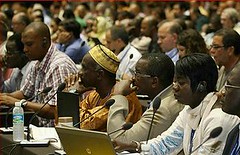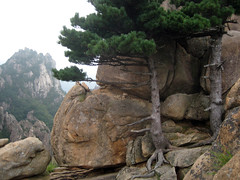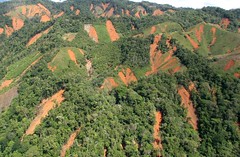全球性 新的保育工具誕生了!世界自然保育聯盟(IUCN)在9日登場的世界保育大會期間,首度發表了《生態系紅皮書》(Red List of Ecosystems),這份紅皮書將全球生態系用國際共同認定的風險評估標準界定為「易危」(Vulnerable)、「瀕危」(Endangered)、「極危」(Critically Endangered)三個等級。推出這份《紅皮書》,是因為IUCN認知到他們針對保育類物種提出類似紅皮書的權威性,分類等級也採用相似的系統。
新的保育工具誕生了!世界自然保育聯盟(IUCN)在9日登場的世界保育大會期間,首度發表了《生態系紅皮書》(Red List of Ecosystems),這份紅皮書將全球生態系用國際共同認定的風險評估標準界定為「易危」(Vulnerable)、「瀕危」(Endangered)、「極危」(Critically Endangered)三個等級。推出這份《紅皮書》,是因為IUCN認知到他們針對保育類物種提出類似紅皮書的權威性,分類等級也採用相似的系統。
世界保育大會(World Conservation Congress,WCC)每四年舉辦一次,本次會期將持續15日,共有來自170個國家8000名政府與非政府組織、科學家、商界代表及社區領導人至濟州島與會。
IUCN《生態系紅皮書》計畫召集人Jon Paul Rodriguez表示,「由於不永續的使用方式及其他威脅,自然環境正處於與日劇增的壓力下。我們將評定在地、區域及全球尺度下,海洋、陸域、淡水及地下水生態系的狀態。」
全世界生態系評估仍在進行中,一旦完成後將發表區域尺度的評估結果。預定將於2025年完成全球海洋、陸域、淡水及地下水生態系評估。
生態系指的是有多樣生物居住其間並會彼此互動的陸域或水域環境。舉例來說:單個湖泊或是一組湖泊、一座山或是山脈、一條河或是整條河流域、一座珊瑚礁或是整個礁區、沙漠或是洞穴都可以是一個生態系。
藉由評估生態系崩潰及生態系服務潛在損失的風險,生態系紅皮書可作為包含土地使用規劃、投資優先順序等保育行動的綱領。這將成為保育者希望重建生態系及改善治理方式的行動基準。
 《生態系紅皮書》也可讓公眾意識到對生態系統所提供服務的威脅,諸如乾淨的水、氣候調節及自然產品。
《生態系紅皮書》也可讓公眾意識到對生態系統所提供服務的威脅,諸如乾淨的水、氣候調節及自然產品。
IUCN生態系經營計畫主持人Edmund Barrow表示,「我們希望它可成為對經濟學者、農村社區、在地和國家當局的快速資訊站,這些人藉由生態系紅皮書的協助可以更佳的管理地球有限的資源。」
《生態系紅皮書》與IUCN《瀕危物種紅皮書》的目的,都在衡量滅絕的風險。IUCN認為紅皮書可影響生物多樣性公約等國際公約的決策。它也將會成為數個聯合國千禧年發展目標(Millennium Development Goals)的指引,包含減少貧困和促進健康,它們都和健康的天然環境息息相關。
生態系紅皮書的建立過程始於2008年IUCN世界保育大會。從那之後,IUCN生態系經營委員會致力於藉由評估生態系崩潰的風險來建立分類標準。
表彰保護區成果 也將推出綠皮書
 IUCN也準備於2014年將於澳洲舉行的IUCN世界保護區大會中,推出《綠皮書》(Green List)。《綠皮書》是用來表彰受到良好管理的保護區的成功、獎勵創新、卓越、規劃,且將成為IUCN稱之為「共同標準的門檻」的行動基準。
IUCN也準備於2014年將於澳洲舉行的IUCN世界保護區大會中,推出《綠皮書》(Green List)。《綠皮書》是用來表彰受到良好管理的保護區的成功、獎勵創新、卓越、規劃,且將成為IUCN稱之為「共同標準的門檻」的行動基準。
IUCN全球保護區計畫主持人Trevor Sandwith表示,「對有效保育的保護區而言,IUCN綠皮書將呈現出其價值。」IUCN全球保護區計畫將與世界保護區委員會共同監督綠皮書的建立過程。
Sandwith認為,「符合標準的保護區將透過綠皮書成為全世界的楷模,這將為這些保護區提供動力。」他認為綠皮書的優點還包括「讓全球更加瞭解保護區、增加官方支持、吸引優質觀光及增進保護區工作人員的動力。」。
計畫初期,將以哥倫比亞國家公園管理單位、南韓國家公園管理處及WWF的老虎保育計畫進行測試。
 哥倫比亞國家公園首長Julia Miranda Londoño表示,「我決定接受這個盛情邀請,讓哥倫比亞成為這個創新計畫施行的其中一國。我發現它在確認國內哪些國家公園做好所有經營管理工作非常實用。」「對於提升保護區管理標準,表揚正向案例是個很好的方法;這將使哥倫比亞的自然資源保育做得更好。」
哥倫比亞國家公園首長Julia Miranda Londoño表示,「我決定接受這個盛情邀請,讓哥倫比亞成為這個創新計畫施行的其中一國。我發現它在確認國內哪些國家公園做好所有經營管理工作非常實用。」「對於提升保護區管理標準,表揚正向案例是個很好的方法;這將使哥倫比亞的自然資源保育做得更好。」
IUCN綠皮書用來協助政府及其他保育伙伴,達成2010年生物多樣性公約大會訂定的「愛知目標」(Aichi Targets),尤其是第11項目標。第11項目標是:至2020年為止,至少17%的陸地與10%的海洋應被「有效及公平的管理與保存」。
IUCN表示,「面臨氣候變遷與災難風險的增加,我們亟需生態系層級的標準;不僅是為了喚起對它們面臨的威脅的意識,也為了證明改善生態系經營可以降低風險、提高韌性,且是適應的一種手段。」
A new conservation tool – the Red List of Ecosystems – debuted today at the World Conservation Congress to identify entire ecosystems that are Vulnerable, Endangered, or Critically Endangered based on an agreed, internationally accepted set of criteria for risk assessment.
Known for its authoritative Red List of Threatened Species, which creates the same classifications for individual species, the International Union for the Conservation of Nature, IUCN, today introduced the new Red List at its World Conservation Congress.
Held once every four years, the Congress runs through September 15. Some 8,000 people from 170 countries have gathered on Jeju Island representing government agencies and nongovernmental organizations as well as scientists, business and community leaders.
“Natural environments are under increasing pressure from unsustainable use and other threats,” said Jon Paul Rodriguez, leader of the Ecosystems Red List Thematic Group with the IUCN Commission on Ecosystem Management. “We will assess the status of marine, terrestrial, freshwater and subterranean ecosystems at local, regional and global levels,” he said.
The process for assessing the world’s ecosystems is ongoing, and regional assessments will be published as they become available.
Complete global coverage of all of Earth’s marine, terrestrial, freshwater and subterranean ecosystems is planned for 2025.
An ecosystem is an area of land and/or water and the diverse species living there that interact together. For example, an ecosystem could be a lake or system of lakes, a mountain or mountain range, a river or river basin, a coral reef or group of reefs, an expanse of desert or a set of caves.
The Red List of Ecosystems can help guide conservation action, including land use planning and investment priorities, by evaluating the risks of ecosystem collapse and the potential loss of ecosystem services.
This then forms the basis for actions that conservationists hope will lead to ecosystem restoration and improved governance.
The Red List of Ecosystems also can be used to inform the public about threats to the services that such ecosystems provide, such as clean water, climate regulation and natural products.
“We envision that it could become a one-stop shop for economists, rural communities, local and national authorities, who can use the assessments of the Red List of Ecosystems to better manage the finite resources of our planet,” said Edmund Barrow, who heads the IUCN Ecosystem Management Programme.
The Red List of Ecosystems is intended to be consistent with, and complementary to the IUCN Red List of Threatened Species, which measures extinction risk.
The IUCN believes that the Red List of Ecosystems can influence the policy process of international treaties, such as the Convention on Biological Diversity.
It could guide investments for several Millennium Development Goals, such as poverty reduction and health improvements, as both are dependent on healthy natural environments.
The process for establishing an IUCN Red List of Ecosystems was launched at IUCN’s World Conservation Congress in 2008. Since then the IUCN Commission on Ecosystem Management has focused on defining assessment criteria for categorizing ecosystems according to their risk of collapse.
The IUCN is preparing to introduce another list – a Green List – in two years at the next IUCN World Parks Congress to be held in Australia in 2014.
The Green List of Well-Managed Protected Areas will celebrate successes, rewarding innovation, excellence and enterprise and acting as a benchmark from what the IUCN calls “a threshold of agreed criteria.”
“The IUCN Green List will make a valuable contribution to the more effective conservation of protected areas,” says Trevor Sandwith, director of IUCN’s Global Protected Areas Programme, which is overseeing creation of the new list together with the World Commission on Protected Areas.
“The Green List will serve as a powerful motivator, inspiring protected areas to meet the standards and be shining examples of global best practice,” Sandwith said.
Advantages of inscription on the IUCN Green List include “greater international recognition for the protected area, increased political support, interest in quality tourism and stronger motivation among managers and other staff,” Sandwith said.
The initiative is currently being tested through projects with Parques Nacionales Naturales in Colombia, the Korean National Parks Service and Conservation Assured/Tiger Standards, a WWF-managed tiger conservation program in tiger range states.
Julia Miranda Londoño, director of Parques Nacionales Naturales Colombia, said, “I decided to accept the generous invitation for Colombia to be one of the countries in which this innovative initiative is developed because I find it extremely useful for our country to determine which national parks are doing a good job related to all issues on the management effectiveness of protected areas.”
“Sharing good practices is a very good way to raise the standards of management of the protected areas, which in the end will result in better nature conservation in Colombia.”
The IUCN Green List is intended to assist national governments and their conservation partners to meet their goals under the Convention on Biological Diversity’s Aichi Targets, particularly Target 11, which states that by 2020 at least 17 percent of the world’s terrestrial areas and 10 percent of coastal and marine areas should be “effectively and equitably managed and conserved.”
The IUCN says, “With climate change and increased risks of disasters, we urgently need criteria at the ecosystem level to not only raise awareness about their threats, but to also demonstrate how improved ecosystem management can reduce risks, enhance resilience, and be a means for adaptation.”
※ 全文及圖片詳見 ENS







